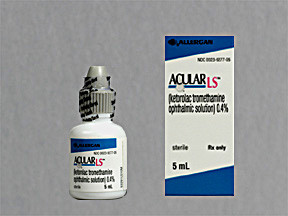KETOROLAC 0.4% SOLUTION - OPHTHALMIC
PHONETIC PRONUNCIATION: (KEE-toe-ROLE-ak troe-METH-a-meen)
COMMON BRAND NAME(S): Acular LS
GENERIC NAME(S): ketorolac tromethamine
Uses
USES: This medication is used to relieve eye pain, burning, and stinging following a certain type of corrective eye surgery (corneal refractive surgery). Ketorolac belongs to a class of drugs known as nonsteroidal anti-inflammatory drugs (NSAIDs). It works by blocking certain natural substances in your body to reduce pain and swelling.
How to use KETOROLAC 0.4% SOLUTION - OPHTHALMIC
HOW TO USE: Apply this medication to the operated eye(s) as directed by your doctor, usually 4 times daily as needed. To apply eye drops, wash your hands first. To avoid contamination, do not touch the dropper tip or let it touch your eye or any other surface. This medication should not be used while wearing contact lenses. Consult your doctor or pharmacist for details. Tilt your head back, look upward, and pull down the lower eyelid to make a pouch. Hold the dropper directly over your eye and place one drop into the pouch. Look downward and gently close your eyes for 1 to 2 minutes. Place one finger at the corner of your eye (near the nose) and apply gentle pressure. This will prevent the medication from draining out. Try not to blink and do not rub your eye. Repeat these steps for your other eye if so directed. Do not rinse the dropper. Replace the dropper cap after each use. If you are using another kind of eye medication (e.g., drops or ointments), wait at least 5 minutes before applying other medications. Use eye drops before eye ointments to allow the eye drops to enter the eye. This medication is usually used for up to 4 days after eye surgery or as directed by your doctor. Do not apply this medication more often than prescribed or continue using it for longer than directed by your doctor. Prolonged use of ketorolac eye drops (more than 2 weeks) may increase the risk of very serious side effects of the eye. Inform your doctor if your condition persists or worsens.
Side Effects
Precautions
Interactions
Overdose
Images
Reviews
Disclaimer
IMPORTANT: HOW TO USE THIS INFORMATION: This is a summary and does NOT have all possible information about this product. This information does not assure that this product is safe, effective, or appropriate for you. This information is not individual medical advice and does not substitute for the advice of your health care professional. Always ask your health care professional for complete information about this product and your specific health needs.


No Reviews Yet